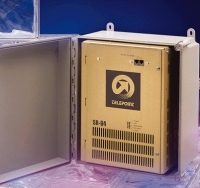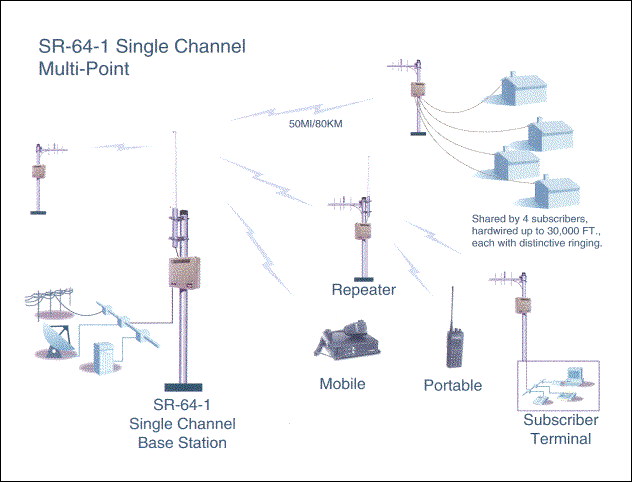
SR-64
SR-64
SR-64-1 / SR-64-2 Community Radio Telephone Exchange
MaxiTel SR-64 Wireless point-to-multipoint multi-protocol local area networking system is a new migration of the SR-20 family of radio telephone line extenders designed to provide wireless telephone service to remote subscriber locations where there is no wire or cellular service available. With MaxiTel SR-64, up to 64 subscribers per single radio channel can be networked serving one single communication path at a time using proprietary TelePoint Networking Protocol to interconnect terminals. The system is designed for voice, fax, and 14.4 Kbps data transmission with the same audio quality and commanded transmission techniques used on other TelePoint systems.
A typical MaxiTel SR-64 system is composed of one master base station and 1 to 64 subscriber terminals using fully synthesized interchangeable Motorola RF modules. The base station is configured to interconnect a wide range of land line gateways, switching equipment, satellite hubs, and terrestrial Microwaves. The subscriber terminal connects to a customer’s standard telephone set, facsimile, line modem and computer, and/or any other standard customer premise equipment (CPE). Both the base station and subscriber terminal are powered by 12-14 VDC or 100/220 VAC/50-60 Hz optional AC transformer, or may be solar powered. High gain omni directional antenna at the base and Yagi directional antennas at the subscriber terminal end are recommended.


Operating Description
When an incoming call to a subscriber is initiated at the C.O., the base station will answer and replies by a series of beep tones. The caller then must dial the two digit extension number of the subscriber. The base station broadcasts a command to subscriber terminals. However, only the subscriber terminal associated with the identifying address will generate a ringing signal. The subscriber will ring as many times as the base station has been programmed (1-10 rings). This feature allows flexibility in limiting the amount of time the radio channel is kept busy by an incoming caller. When the subscriber answers the ringing signal by going off hook, its transmitter will power up and transmit an acknowledgment.
When a call is initiated either from a subscriber or the C.O., all other subscribers will experience a busy signal and remain locked until the call is terminated. A subscriber wishing to place a call may confront a busy signal, as soon as the C.O. line is available, the subscriber will receive a ring back to acknowledge the line availability.
Once the link is established, voice, fax, or data is transmitted over the radio channel via a 2 or 4 wire circuit between the C.O. and the subscriber. The system can handle up to 64 subscribers with their own automatic number identification (ANI). The subscribers can be assigned ID numbers using the standard DTMF telephone set attached to the subscriber terminal. Any subscriber can be disconnected or added to the system by eliminating the subscriber ID from the base station terminal using a standard telephone set.
For billing purposes, SR-64ís call accounting and management control option can monitor and control the telephone traffic to and from theC.O. associated with all users according to their addressable ID numbers. The subscribers can be controlled or disconnected from service at any time through the base station.

FEATURES
- Overdial with tone confirmation
- Busy lock-out and privacy
- Call back
- Addressable remote units in Selective, Broadcast, Group, or SubNets mode
- Full duplex selective intercom base to subscriber or VS and optional subscriber to subscriber
- 1 to 64 subscriber terminals with individual ANI (automatic number identification)
- Call accounting for billing and management control
- All features programmable via standard telephone set attached to base station, no computer terminal necessary
- Fully synthesized, programmable RF power and frequency
- 100% duty cycle at any RF power setting
